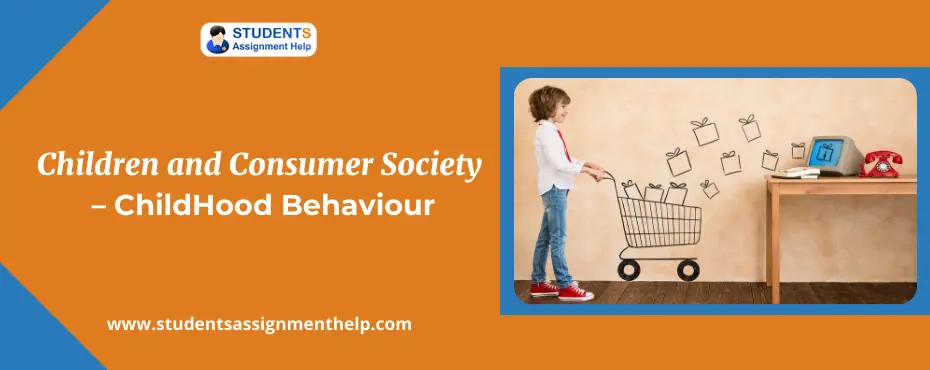Children and Consumer Society – ChildHood Behaviour

Introduction: Children and Consumer Society
The consumer society comprises of a range of people from different demographic variables. One such demographic variable is age. Children and young consumers are affected in different ways by the interaction with the consumer society. The consumer society is the society in which the activity of buying and selling of goods and services is the most important economic and social activity. Children have not just remained passive consumers. Instead, they have become an important part of the overall consumerism and related marketing and advertising efforts[1]. The essay discusses different ways in which the consumer society interacts with children and young consumers and considering that the consumer society is not just something that has just a negative impact on childhood.
Interaction of consumer society with the childhood
With the advent of the medium of television in the early 20th century, the marketers and advertisers quickly realized that they could use the medium to bring the products to the attention of mass audiences, including both young and old, thus ensuring an enormous supply of children and adults to businesses. Today, activities related to marketing and advertising permeates the daily lives of children. Children that are young often do not understand the persuasive intent of ads and, even the older children face the difficulty in understanding the intent of marketing techniques that are newer which then blur the line between the commercial content and the regular content[2].
Television has long been the staple of advertising to children and young people. Each year, children view approximately 40000 ads with major products marketed to the children are fast food services, sugar-coated cereals, toys, candies, etc. Children are also becoming the target of these products online. Due to the exponential increase in the buying power of children and young consumers over time, the youth has become a market that is eminently worthy of pursuit by businesses[3].
It has shaped the buying patterns of the families ranging from choices of vacations to purchasing a car to selecting the meal. Children and youth as part of the consumer society exert a tremendous level of power over the pocketbook of the family. According to the estimation by experts, two-to-fourteen years old in the US have sway over more than $500 billion a year in the activities of household purchasing. Therefore, the act of influencing youth is actually the act of influencing the buying decisions of the entire family.
As a result of the rapid growth of online venues and television stations, there is direct marketing to children and youth by the advertisers. It is due to the reason that children and youth are the heavy users of the media and are early adopters, media marketing, newer technologies and ad campaigns that are efficient pathways into homes and lives of children. Advertising influences the consumer-related knowledge, values, attitudes, and behaviors of individuals of children. Researchers have found out the positive relationship between the amount of exposure to ads and the overall degree of effect that is exercised by them[4]. One of the major reasons for such a positive relationship is the high levels of exposure and the repetition of ads leading to the increase in the memory of the child for ads, and that is important while assessing the long-term effects[5].
In older children, cognitive skills are higher. Therefore, they are able to understand the commercial intent that is prevalent in the consumer society and they also often use the entire apparatus of the cognitive defense against the consumer commercials, which may result in negative attitudes such as distrust and cynicism towards the advertisement. There are less favorable attitudes among older children in comparison to younger children. Educational background and social class of the parents also play a role in the interaction between the consumer society and childhood[6].
Parents are partly influenced by their social class and educational background and are indirect influence of it on the attitude and behavior of children as consumers. The overall purchasing environment created by parents set the interaction between the child and TV ads. In most of the research studies, there is a linking of parents from the lower social classes to higher amounts of TV exposure and also the ads of the higher exposure to the ads for the children. In terms of direct influence, parents influence the behavior of their children through direct provision of the comment on TV ads and the products that they purchase in the market as part of the consumer society. The moral judgment of parents, the subsequent explanation about the comments on the issues that are presented in TV ads[7].
Most researchers agree that parents have an important role to play as responsible mediators of interactions of the children with the TV. Co-viewing of the parent-child is usually more frequent with the older children rather than the younger children as the tastes of older children will be more similar to those of the parents[8].
Own purchase behaviour of children
There is a general perception that adults are less vulnerable to the advertising and marketing of goods and services. In the UK, it is estimated that there are almost 13 million children that are under the age of sixteen and nearly 70 percent of them receive pocket money. It is the representation of considerable spending power of children and young people in the consumer society. In the western markets, there is a relatively new development of the concept of ‘children’s market’. There are concerns over the ways in which the commercialization of childhood is making an impact on the pester power and the presence of persuasive kids. In consumer society, children are an important consumer market and are not just seen as passive consumers of products and services.
Children have become the spenders by transitioning from the tag of being only savers. As an example of the development of the children’s ad market, in the UK, there was a declaration of no advertising of the high fat, salt food products or sugar products on the TV channels of children. IN the USA, the advertising campaigns for children include approximately the expenditure of $15 billion. In the consumer society, children are viewed as integrated into the practices of consumption either as individuals or as members of the family.
Looking at the consumption of children from the perspective of consumer culture, children and young people are not only passive consumers in the market nor there are just negative influences of the products or services in the consumer society. Taking children and young consumers as the target, successful marketing campaigns use branded characters as the form of interaction between children and the consumer society. These characters appear appealing to the children.
For example, companies obtain the right to use favorite cartoon characters, such as Nickelodeon’s Sponge-Bob SquarePants help in increasing the selling to the products ranging from foods to vacations. Companies also use animated characters for specific products, such as Tony the Tiger as a spokesperson for a particular product, such as Kellogg’s Frosted Flakes. In a similar way, the character of Ronald McDonald is used for the purpose of selling the McDonald’s brand that also includes Happy Meals.
The use of premiums, such as small toys in Happy Meals also increases the purchases of the product on television and online. Online interactive agents are another form of interaction between the consumer society and childhood. There are many These agents are the virtual form of stealth advertising. Program robots of marketers, named as bots are used for replying to the users in a relational way that is one-on-one. The use of video games is also one of the forms of communication between tech-savvy children and consumer society. Marketers build brand awareness and loyalty through the development and use of video game applications targeted at consumers. If a game is successful, it means that the consumer is interested, engaged and focused well on the product.
Conclusion
Children have become an important part of consumer society. They are now specifically targeted in marketing and advertising campaigns. Owing to the advent of the internet as well as media channels, the consumer society has become attentive towards the needs, attitudes, behaviors, and values of children. There is presence of various ways in which the consumer society interacts with the children and young consumers. The attitude and buying patterns of parents along-with their social class and the educational background also affect the way in which their children are influenced by various products and services in society. There are differences in the attitude of younger children in comparison to the older children. Accepting the fact that children are an active part of the consumer society, marketers have started using specific marketing and advertising campaigns for targeting children and young people. The use of video games, children specific cartoon characters and developing specific marketing campaigns for children and young people has become prominent in consumer society. Thus, it can be reinstated that children and young people are not only passive consumers in society.
References
Belk, R.W., Research in Consumer Behavior, Emerald Group Publishing, 2010.
Bragg, S. and Kehily, M.J., Children and young people’s cultural worlds, The Policy Press, 2013.
Calvert, S. .L., ‘Children as Consumers: Advertising and Marketing’, The Future of Children, Vol 18 , no.1, 2008.
Cook, D.T., The Commodification of Childhood: The Children’s Clothing Industry and the Rise of the Child Consumer, Duke University Press, 2004.
Furnham, A.and Gunter, B., Children as Consumers: A Psychological Analysis of the Young People’s Market, Routledge.
Jane, B.and Jane, D., Understanding Advocacy For Children And Young People, McGraw-Hill International, 2009.
Marshall, D., Understanding Children as Consumers, SAGE, 2010.
Ministered, N.and Rad, N., Teaching Consumer Competences: A Strategy for Consumer Education, Nordic Council of Ministers, 2009.
Smart, B., Consumer Society: Critical Issues & Environmental Consequences, SAGE, 2010.
D.T.Cook, The Commodification of Childhood: The Children’s Clothing Industry and the Rise of the Child Consumer, Duke University Press, 2004.
A.Furnham and B.Gunter, Children as Consumers: A Psychological Analysis of the Young People’s Market, Routledge.
D.Marshall, Understanding Children as Consumers, SAGE, 2010.
D.Marshall, Understanding Children as Consumers, SAGE, 2010.
D.Marshall, Understanding Children as Consumers, SAGE, 2010.
S.L. Calvert, ‘Children as Consumers: Advertising and Marketing’, The Future of Children, Vol 18 , no.1, 2008.
B.Jane and D. Jane, Understanding Advocacy For Children And Young People, McGraw-Hill International, 2009.
R.W. Belk, Research in Consumer Behavior, Emerald Group Publishing, 2010.
N.Ministerrad and N.Rad. Teaching Consumer Competences: A Strategy for Consumer Education, Nordic Council of Ministers, 2009.
L. Calvert, ‘Children as Consumers: Advertising and Marketing’, The Future of Children, Vol 18 , no.1, 2008.
L. Calvert, ‘Children as Consumers: Advertising and Marketing’, The Future of Children, Vol 18 , no.1, 2008.
B.Smart, Consumer Society: Critical Issues & Environmental Consequences, SAGE, 2010.
S.Bragg and M.J. Kehily, Children and young people’s cultural worlds, The Policy Press, 2013.

